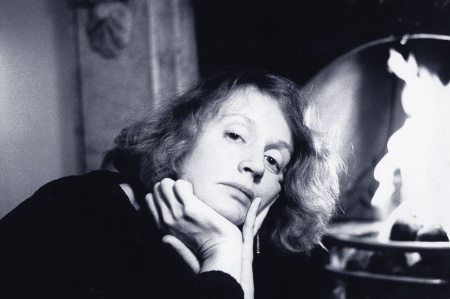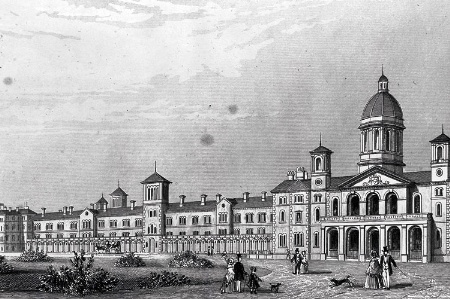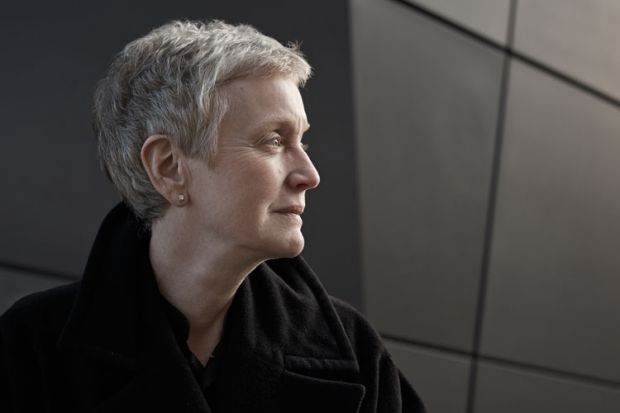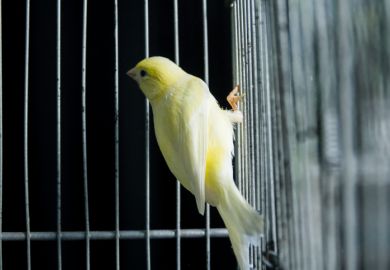Source: Peter Searle
Friern provided her with what, in a time of crisis, she ‘needed most: asylum, a safe place to be, a “stone mother” to hold me for as long as I required it’
Barbara Taylor can look back on about a decade of her life lost to mental illness. She is now professor of humanities at Queen Mary University of London and 30 years ago she seemed to be set on exactly the right course to achieve this.
Having moved from Canada to London aged 21, by 1983 Taylor had completed a PhD and her first book. Although she began her doctorate in philosophy and had not studied history since high school, her commitment to the women’s movement had led her to switch track and embark on a thesis that became Eve and the New Jerusalem: Socialism and Feminism in the Nineteenth Century. She had already landed her first academic post and she had plans for a study of the pioneering 18th-century feminist Mary Wollstonecraft.
But something was badly wrong. Taylor had suffered a breakdown and was seeing a psychoanalyst. Faced with painful and destructive thoughts, she turned to drink and pills.
“By the time Eve was published in 1983,” she recalls when we meet at a cafe near her home in Crouch End, “I was incapable of doing any sustained work. I struggled on, the next project flowed so naturally out of it that I knew how to go about it, but I just wasn’t capable.” Among the obstacles she faced was that “I usually couldn’t read. The only time I could read was last thing at night. Losing the capacity to read was just agony.” It was years before she returned to the project – “I literally blew the dust off my files” – and eventually brought it to completion as Mary Wollstonecraft and the Feminist Imagination (2003).
It is this story of collapse and slow recovery that Taylor has charted in a new book, The Last Asylum: A Memoir of Madness in our Times.
By 1985, she writes, she “had lost all semblance of ordinary life; three years further on I was admitted to Friern”. This was Friern Hospital, formerly the Middlesex County Pauper Lunatic Asylum at Colney Hatch, once “England’s biggest and most advanced psychiatric institution”. But by the time Taylor spent six months there over three separate periods in 1988-89, it was scheduled for closure and she found herself unwittingly living through “the twilight of the Asylum Age”.
Friern has now been transformed into luxury apartments as Princess Park Manor, and in The Last Asylum Taylor has a good deal of fun dissecting sales literature that talks of a “Victorian masterpiece which has delighted and inspired aficionados of fine architecture for generations” with its “distinguished history” and “aura of grandeur”. (The advertisements even mention the “robust, thick, well insulated” walls that “inspire feelings of security and cosiness”.) Stranger still was her purchase many years later of several metres of oak floorboards, bringing “a touch of souvenir elegance” to her home, which the salesman later told her came from Friern.

The late 1980s were already the era of “community care”, which Taylor argues is usually a euphemism for “women struggling, often with meagre resources, to look after loved ones who are too crazy or old or physically incapacitated to look after themselves”. Yet, on leaving Friern, she received support from an “adult adoption” scheme (social services found her “a room in the house of a retired nurse who would provide meals and generally be there for me”) and spent much of her time in a series of day hospitals, day centres and hostels. Like the great Victorian asylums, many of these have now closed.
Through her roughest years of drinking, despair and self-destruction during the late 1980s, Taylor retained a circle of mainly female friends who were willing to provide support and carefully organised her life around them. “I knew that if I just rolled up drunk at someone’s house, that would be it. People had lives and children. So I would set up what a friend called ‘Barbara-sitting’ rotas of people who said ‘Come round to me today’. After my [psychoanalytic] session, I would go round at some point, they would give me some lunch and I would go to lie down for a ‘nap’. I carried alcohol with me and had enough to go into a sort of doze.”
Even during her early days in Friern, Taylor had so many visitors that the doctors said they were going to have to get a secretary for her. When one of her mentors, the historian Raphael Samuel, came to see her, he couldn’t help exclaiming: “Darling Barbara! What a privilege for you, a historian, to be present at the demise of one of the last great Victorian institutions!”
However apparently insensitive, this remark continued to echo with Taylor as she reflected on her experiences in later years: “I had found myself a witness as well as a participant in a really major historic shift in mental health provision. Raphael was very important to me and his sense of excitement at being inside this change really stuck with me…I had one foot in the old asylum system and the other inside some of the new forms of community care.” Along with a vivid and often harrowing account of what she went through, The Last Asylum offers a historian’s insight into these larger themes.
“Bin memoirs”, as Taylor herself points out, are “a peculiar genre”, sometimes “lurid tales of decent, healthy people consigned to asylums by evil or stupid doctors”, sometimes accounts of asylum life as “cruel and degrading” and just occasionally “depicting the asylum as a place of healing, a sanctuary from the madness of ‘normal’ life”.
Her own memoir describes the history of cruelty and abuse, the stigmatising of patients (when she mentioned she had written a book, this was dismissed by one nurse as a “piece of blatant make-believe…as improbable as flying”) and the constant humiliation of “ward rounds” (individual patients were summoned into a separate room before a whole group of mental health professionals and then required to put on a “degrading staging of [themselves] before a roomful of strangers”). She explores the ways that money, class and “cultural capital” still created hierarchies within Friern. And she notes that, although most of the nurses were “civil even under pressure” and some were “pleasant in that patronizing way that was once the high point of asylum etiquette”, few were “ordinarily kind and friendly”.
Yet this is only one side of the story. The asylum forced Taylor to acquire forms of “competence” she had never needed before. It made her kinder to people from different backgrounds and made her see she had “long been a friendship snob, priding myself on the cleverness and the sophistication of my social network”. Above all, Friern provided her with what, in a time of crisis, she “needed most: asylum, a safe place to be, a ‘stone mother’ to hold me for as long as I required it”; changes in mental health provision mean that such “havens” are unavailable today. To that extent, she believes, the end of the often unhappy Asylum Age represents a loss of something valuable.

Taylor decided, ‘I was either going to tell the story or not tell the story. If students read it, some may be taken aback, but I hope more young people in trouble might come to talk to me’
When she was planning The Last Asylum, Taylor realised that “it was in the history of medicine, loosely speaking, and there would be the possibility of Wellcome Trust funding under their new Medical Humanities department. They were incredibly supportive, so I applied and got a year’s funding to buy me out of teaching. I stressed the themes of friendship and social relationships within asylums and among communities of people with severe mental illness, an area on which very little work has been done.”
It is here that Taylor’s new book links up with the theme of the one before, On Kindness, which she wrote with the psychoanalyst Adam Phillips. Arguing that we live in “a society that denigrates kindness”, they set out the case for “ordinary, unsentimental kindness” which is “not a temptation to sacrifice ourselves, but to include ourselves with others”, adding that “feelings of connection and reciprocity are among the greatest pleasures that human beings can possess”.
Following the publication of On Kindness in 2009, there were comments along the lines that ordinary decent people didn’t need lectures from sophisticated intellectuals about the value of kindness. The Last Asylum adds an extra emotional dimension to the earlier book by revealing just what a personal issue this was for Taylor, as she struggled to find kindness from friends and strangers, and to access the kinder, less self-flagellating parts of herself. And that, she agrees, reveals an essential truth: “It’s failures of care that drive people crazy and good care, good forms of relating, that heal people up again.”
So what were the factors that helped Taylor to survive, recover, return to the academy in 1993, fall in love with a suitable partner and forge a successful career? In addition to a wide network of friends, she had parents willing and able to provide financial support. Although she encountered some ghastly psychiatrists, including one who advised her to return to Canada and marry a farmer, the main one proved to be excellent and, crucially, was sympathetic to psychoanalysis. She was therefore able to continue, eventually for 21 and a half years, a course of intensive psychotherapy that she believes enabled her “to break out of the carapace in which I contained myself…The alternative would have been becoming a long-term invalid, with ME or something similar, very incapacitated, or an alcoholic. Some form of long-term, life-draining, miserable incapacitation.”
Although well aware that this combination of background, circumstances and luck makes her case hardly typical, Taylor uses her book both to ask a personal question – “What would happen to me now, were I a young woman in the midst of a severe emotional breakdown?” – and to draw out some of the wider issues for mental health provision.
As well as a “bin memoir”, therefore, The Last Asylum offers an often gruelling account of a successful psychoanalysis.
“I was dying on my feet when I went into analysis,” she says now. “When I think about myself in those years, I absolutely loathed myself and I didn’t believe that anyone liked themselves. It seemed to me that self-hate, self-dislike, self-revulsion were the way people were – I thought it was integrity.”

Determined to “counter the view that in-depth psychotherapy doesn’t work for serious mental illness”, Taylor therefore tries to describe exactly what it was like to live through. Like her analyst, readers are spared few details of her drunken binges, inconsiderate behaviour, tormented relationships, changing feelings about her genitals, violent and sometimes horrifying fantasies. Her analyst may have needed to hear all this, but did she never have concerns about revealing it to the general public, not to mention colleagues and students?
Once embarked on the project, Taylor replies, she decided “I was either going to tell the story or not tell the story. That is what it was about. That is what happened.
“If my students read it, some may be taken aback, but I hope that more young people who are in trouble might come to talk to me – kids are under so much strain these days.”
Today, of course, mental distress is generally treated with drugs and psychological help in the form of time-limited (and sometimes computerised) cognitive behavioural therapy. Although this may well be inadequate, it is hard to imagine the NHS offering daily psychoanalysis for more than 20 years any time soon.
Taylor acknowledges this but she also suggests that “before people just dismiss out of hand the idea of having lots of psychoanalysts around, we need to think of the costs of mental illness to our society at every conceivable level. Psychological therapies, done by highly qualified people, of some intensity and duration could be made widely available. The idea that it’s completely impossible doesn’t take into account just how much it’s costing our society not to look after people properly.
“The main general issues are questions of care in the context of an infatuation with independence, autonomy and self-reliance in our society, and just how destructive it is for that ethos to spread through the mental health services. That makes it difficult to put people into a sustained form of care and community which might really make a difference. It is a story you hear from just about anyone working in mental health services.”
Register to continue
Why register?
- Registration is free and only takes a moment
- Once registered, you can read 3 articles a month
- Sign up for our newsletter
Subscribe
Or subscribe for unlimited access to:
- Unlimited access to news, views, insights & reviews
- Digital editions
- Digital access to THE’s university and college rankings analysis
Already registered or a current subscriber? Login





